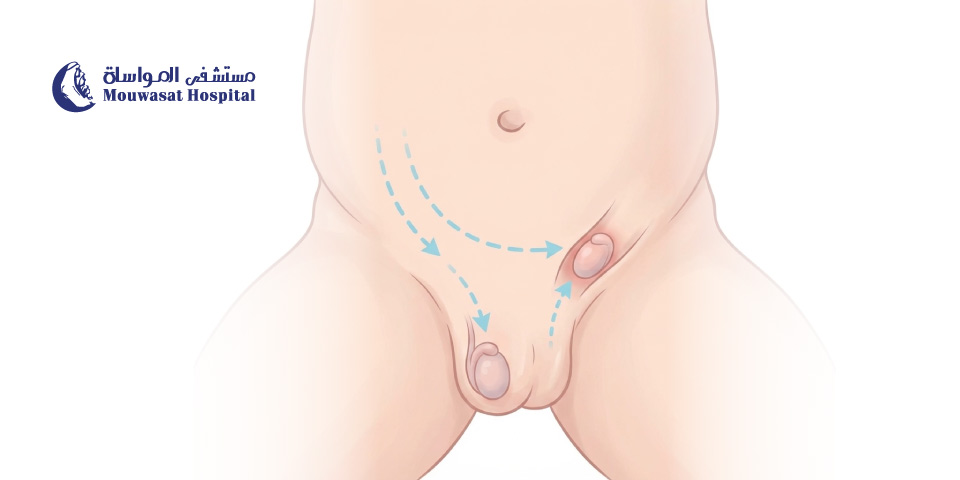-
About Mouwasat
About Mouwasat
Mouwasat Medical Services was Founded in 1975 in Dammam as an individual entity.
-
Academic Affairs & Researches
-
Contact Us



An undescended testicle in children is a common condition that often worries parents, especially when they notice one or both testicles missing from scrotum.
Many parents ask questions like:
What is the best age for surgery?
In this article, we will cover in detail the causes, symptoms, treatment options, and complications of undescended testicles, as well as their impact on fertility.
Before birth, the testicles develop inside the abdomen of a male fetus. Shortly before delivery, they move through the inguinal canal and descend into the scrotum. Normally, this process is completed before birth.
However, in some babies, especially those born prematurely, one or both testicles fail to descend and remain in the abdomen or groin. This condition is called undescended testicle or cryptorchidism.
In some cases, the testicle may descend naturally within the first six months of life. If not, medical intervention or surgery may be required to ensure the testicle is in its proper position.
The exact cause is unknown, but several factors may increase the risk:
Undescended testicles usually do not cause pain or urinary problems, but there are signs you can look for:
Sometimes the testicle appears and disappears, especially when the child is cold or upset, this is called a retractile testicle, which usually does not require surgery
If you notice any of these signs, consult a pediatrician for proper diagnosis and timely treatment. Add a link to “Pediatrician”, that take the audience to the Pediatric consultant's inner page
Doctors usually detect undescended testicles during a newborn’s physical exam. If your child has this condition, ask about follow-up visits. If the testicle has not descended by 3–4 months, it is unlikely to correct itself.
Older children may develop what appears to be a missing testicle later in life. This could indicate:
Seek medical advice immediately if you notice any changes in your child’s genital area.
Leaving the condition untreated can lead to serious health issues:
Fertility Problems: High abdominal temperature can damage sperm production, reducing future fertility.
Increased Risk of Testicular Cancer: Men with undescended testicles are more likely to develop testicular cancer, especially if both testicles are affected.
Testicular Torsion: A medical emergency requiring immediate surgery to prevent loss of the testicle.
Inguinal Hernia: Part of the intestine may push into the groin through a weak spot in the abdominal muscles, causing a painful bulge. Comment
Delayed Puberty: In some cases, undescended testicles can delay puberty signs.
Psychological Impact: May affect body image and self-confidence during adolescence.
If the testicle does not descend naturally within six months, medical intervention is necessary.
In newborns, doctors may monitor for up to 3 months as the testicle may descend on its own.
Hormone injections were once used to stimulate descent, but this method is now rarely recommended due to limited effectiveness compared to surgery.
The most effective treatment is surgery to move the testicle into the scrotum and secure it.
Used when the testicle is inside the abdomen. The surgeon may correct the position during the same procedure or later if needed.
The Pediatric Surgery Department at Mouwasat Hospital offers comprehensive care for infants, children, and adolescents, including undescended testicle surgery. Key advantages include:
These features make Mouwasat Hospital a trusted choice for safe and effective pediatric surgeries.
Medical Disclaimer
This article is for educational purposes only and is not a substitute for professional medical advice. Always consult a pediatrician for diagnosis and treatment.
Not initially, but if left untreated, it can lead to infertility and increase the risk of testicular cancer.
Yes, sometimes within the first six months. If not, surgery is usually required.
Hormonal therapy is rarely used today due to low success rates. Surgery (orchiopexy) is the most effective treatment.
Between 6 and 18 months for optimal results and reduced complications.
About 30–60 minutes, and most children go home the same day.
General anesthesia with child-specific safety protocols.
Most children resume normal activities within 1–2 weeks.
Read more:
Umbilical Hernia in Children: Causes, Symptoms, and Treatment
Inguinal Hernia in Children: Causes, Symptoms, and Treatment